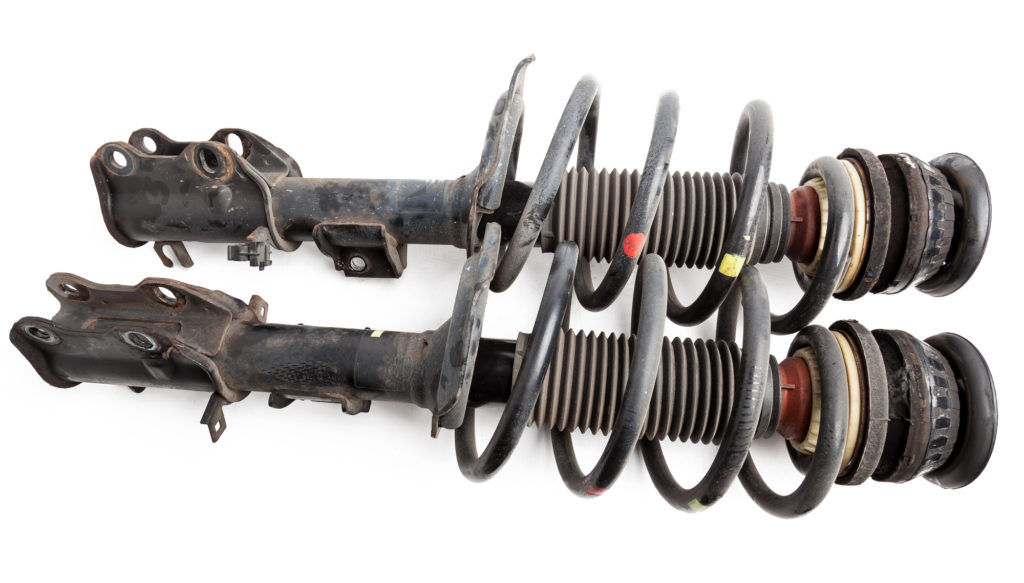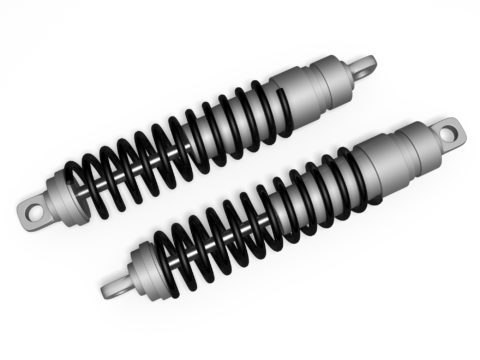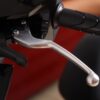Like any other part of an automobile, struts can go wrong for various reasons, and you can keep an eye out for several different symptoms to detect bad struts in your car. This short guide will cover the basics of struts and five of the most crucial malfunctioning strut symptoms to watch for.

Contents
What Are Struts on a Car?
Struts on a car are one of the essential pieces for ensuring a vehicle drives smoothly, as they are a core component of most modern-day suspension systems. The struts connect the wheels of a car to the body and typically sit on the front-end side of front-wheel-drive vehicles for functionality purposes.
When a vehicle drives over a surface and experiences some heavy contact, the force from that contact goes into the struts to prevent it from shaking the entire car. So, think of struts as stabilizers for the whole vehicle.
Differences Between Shocks And Struts
The main difference separating shock and struts from each other is the suspension of a vehicle’s weight. Shocks don’t support the vehicle’s weight, whereas struts do.
Some talk about the two components as if they serve the same purpose. They’re not the same even though both affect a vehicle’s overall handling.
What Happens When Struts Go Bad?
Because struts play such a pivotal role in how a car steers, a lot can and will go wrong if the struts of a car go bad.
The most common issue is losing partial or complete control of your vehicle whenever you go over an uneven surface, and this is incredibly dangerous because you only need to lose control of your car for a few seconds to end up in an accident.
Sometimes, you may not experience any loss of control of your vehicle, but you may still notice that your car struggles more in making sharp turns.
Loss of control happens because bad struts make it significantly more difficult for a vehicle’s tires to keep a solid grip on a road, resulting in more squirrely steering.
If the struts are damaged, your car’s wheels may also undergo more significant wear and tear more quickly. Wavy and uneven-looking treads on tires are not things you want to see, but there’s a good chance they’ll appear if you’re regularly driving around with bad struts.
Symptoms of Bad Struts
Here are a few of the most common symptoms of bad struts on a car.
Suspension Feels Unstable
An unstable suspension is one of the most surefire signs of bad struts because they directly affect any vehicle’s suspension.
Suspension can feel unstable from broken or worn-out struts, but other components can also cause the suspension to go awry, so strongly consider having a professional mechanic inspect your vehicle to ensure the struts are faulty.
Wear on the Tires Looks Uneven
Every tire will sustain wear and tear over time, but that wear should always look even if everything is in order. If you check your car’s tires and find that the wear on them is uneven, that’s a good sign that the struts on the vehicle are bad.
Uneven wear isn’t the most common symptom of bad struts, but it’s still one that’s work keeping an eye out for.

Noise Comes from the Front of the Car When Going Over Bumps
When you hear a noise come from the front of the car as you go over a bump, it can mean that the struts are failing to absorb the impact.
The noise may not sound very loud at first, but if the struts are bad, they will continue to get worse, and so will the sound, so you’ll eventually reach a point where you won’t be able to miss it.
Always pay attention to your car’s noises when going over bumps and listen for any that sound particularly out of place. That way, you can tend to any potentially strut-related problems before they worsen.
General Instability
If you’re driving down a road and notice that you’re having to course-correct your car a lot because it’s constantly drifting, it might mean that the front-end struts are broken or going bad.
Instability is one of the more manageable symptoms to detect because you can quickly tell when your car struggles to travel in a straight line, especially at higher speeds.
Along with strut problems, instability can also mean that your wheels are misaligned, so you should get an inspection from a professional mechanic to figure out which is the case.
Anti-Lock Braking System Stops Working Properly
In some cases, driving with bad struts can lead to your car’s anti-lock braking system (ABS) malfunctioning. When the ABS is not working correctly, it can seriously affect your vehicle’s ability to brake quickly and reliably. However, many other things can also cause the ABS to fail.
Unlike the other symptoms, this is probably the least common one, but keep it in mind if you check for all the other possible signs of bad struts first and find nothing
How To Check Struts
If you know how to gain access to your struts, you can directly inspect them, but if you want to test them without going underneath your car, you can try a simple bounce test.
To do this, put your hand on the side of your vehicle that might have a bad strut and push down to see if it bounces back into place. If it keeps bouncing and seems wobbly, the struts have likely gone bad.
How Long Do Struts Last on Average?
Depending on how much use they see, you can expect struts to last between seven and ten years. Cars that do a lot of driving will always start to break down faster than cars that only get taken out on the road now and again, so consider this when checking for bad struts.
Are Struts Worth Replacing?
You don’t have to replace struts until they reach a point where they can no longer do their job correctly. Once your car begins displaying the above-mentioned symptoms, you’ll know it’s time to invest in some replacements.
Where To Replace Struts
Unless you have experience working with automobiles, you should take your car to an auto repair shop where a professional can work on installing the new struts.
The cost of this process will differ depending on what shop you go to, but it’s well worth the price to have a car that you can feel safe driving.














